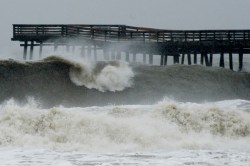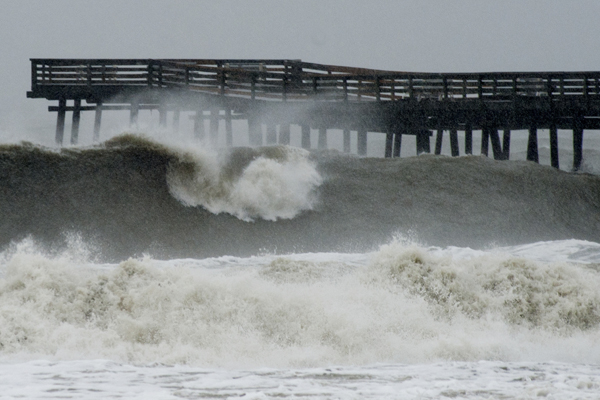
Reuters / Rich-Joseph FacunWaves crash on shore from high surf ahead of Hurricane Sandy at the pier at Virginia Beach.
A recurrence of Superstorm Sandy — which barreled head-on into the Atlantic coast, swamping New York City and large parts of New Jersey — is less likely under climate change, new research suggests.
Scientists expect stronger hurricanes under climate change, and possibly even more frequent storms — especially those at category 3 and higher. But New York City and much of the seaboard will be at lower risk of taking a direct hit, the study published on Monday in the Proceedings of the National Academy of Sciences said.
Instead, climate change will make it even less likely future storms will follow Sandy’s devastating track. The killer storm made a sharp left turn to slam straight into the Atlantic coast. The odds of a storm like Sandy were already extremely remote — a once in 700 year event — when it hit in October 2012. But it was that trajectory that made Sandy so devastating.
“What made Sandy so different was that it was steered into the coast rather than away from it,” said Elizabeth Barnes, a climate scientist at Colorado State University and an author of the study.
The researchers used climate models, based on a tripling of greenhouse gas emissions by 2100, to study whether future atmospheric conditions be more or less likely to blow a storm like Sandy westwards into the Atlantic coast.
They found future air patterns under climate change make a repeat of such a rare event even less likely. Wind and atmospheric conditions, including changes in the jet stream, would be more likely to push major storms further offshore, away from the big population centers along the Atlantic coast, the researchers found.
But, the researchers warned, the findings do not mean Americans can afford to be blasé about the risks to coastal areas from hurricanes and tropical storms. “You can’t let your guard down,” said Barnes.
New York City Mayor Michael Bloomberg earlier this year outlined a $19.5 billion plan to protect the city from future Sandy-like catastrophes.
Such precautions are still necessary say the scientists who caution that their study only looked at the tracking patterns of hurricanes — and not their frequency and intensity which are expected to increase.
There is abundant evidence from that hurricanes are growing more powerful — and inflicting more damage because of climate change. Warmer temperatures generate bigger storms, with stronger winds and heavier rainfall, and over a greater swathe of territory. Sea-level rise leaves coastal cities more at risk from storm surges.
A study last July by a scientist listed as an editor on Barnes’s paper — the MIT researcher Kerry Emanuel — also found there would be an increase in those major hurricanes under climate change, with up to 20 additional hurricanes and tropical storms every year by the end of the century. But it is less clear where those storms would hit.
“What they did in this paper was to look specifically at the steering patterns in the atmosphere,” Emanuel said. Hurricanes and tropical storms that stay out at sea pose less of a threat. But he added: “It doesn’t mean that New York is off the hook if in fact there are going to be more storms overall.”
“There is no question that there is potential for larger destruction from storms and more damage from storms even though the track is going further offshore,” Emanuel said.
And the researchers underlined the connections between hurricanes and climate change were still not entirely understood. “This is just one part of the puzzle,” said Barnes.
 This story first appeared on the Guardian website as part of the Climate Desk collaboration.
This story first appeared on the Guardian website as part of the Climate Desk collaboration.



